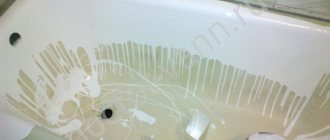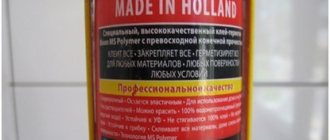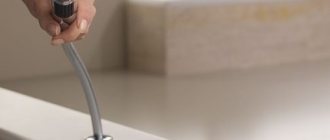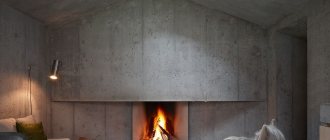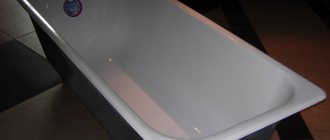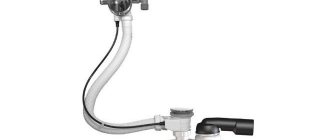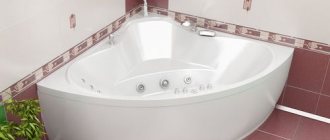According to scientists, a person spends about 13 days a year in the bathroom. This is a place of solitude, relaxation and recuperation. But harmony can be rudely disrupted by one everyday moment - noise. The sound of pouring water or even the crash of dropped shampoo is sometimes terribly annoying.
Foundation calculation
Try a new product
Try for free Find out more
Many owners of metal equipment face this situation. You can save your nerves and solve the problem of poor sound insulation without major expenses. This does not even require the services of qualified specialists. Do-it-yourself soundproofing of bathtubs is a quick and reliable way to reduce noise.
Soundproofing walls and ceilings in a bathroom is a difficult combination
Traditionally, the bathroom is considered the most suitable place in the house where you can train your vocal abilities. However, soundproofing the bathroom will allow you to do this without harming the nervous system of others. Ventilation and waterproofing - do not forget that these processes also need to be taken into account.
As with the toilet, you will need a soundproof door that is resistant to moisture. Of all the soundproofing materials for insulating walls and ceilings, we also choose those that can withstand exposure to steam and do not mold. Mineral wool (glass wool, basalt fiber) is ideal for these purposes.
Sound insulation from a suspended ceiling in combination with mineral wool or thin insulation will be the most optimal - the ceiling film perfectly withstands the effects of warm steam, reliably protecting the materials hidden behind it from moisture.
The floor on top of the screed should be covered with a layer of waterproofing material: a layer of bitumen mastic, sheet material impregnated with bitumen, rubber-based water barriers, there are actually many options. If desired, a soundproofing membrane can be laid down, but the thickness of the floor is usually sufficient to contain sound waves
In the bathroom, it is very important at the finishing stage to treat all joints with silicone sealant, which does not allow moisture to pass through. You can do all this work completely independently.
A little theory: what kind of noise happens ↑
It is a mistake to believe that it is enough to cover the walls with advertised noise-absorbing material and you will be able to enjoy the desired silence when your neighbors flush water into the sewer pipe or your own bathtub is filled with water. Sounds have a different nature of origin and are transmitted not only through the air. Based on the type of noise, it is usually divided into:
- airborne noise is sounds transmitted through the air: neighbors talking, music, dogs barking.
- Structure noise. The most difficult thing to protect against is this type of noise, which comes from vibrations along the walls. This could include water filling the bathtub, washing machine spinning clothes, or objects falling on the floor.
Silence in the house is the main component of comfort
Features of steel baths
Bathrooms, or as they are also called sanitary containers, today use metal models in everyday life, since they are not as expensive as cast iron or ceramic ones, and have a relatively low weight, which is especially convenient for transportation. The service life of a metal structure varies from 20 to 30 years. The inner surface of the bowl is covered with abrasion-resistant enamel. Today on the market, products are offered to customers in any color, which allows you to match the bowl as closely as possible to the main interior design. As for the features of metal baths, they include the following:
Photo: Steel bath. Manarbek Bushuev
- light weight of the product;
- variety of sizes;
- large selection of models;
- wear-resistant enamel coating;
- long service life.
Thanks to its relatively light weight, which is five times less than that of cast iron. A sanitary container can be brought to any floor without unnecessary difficulties, which is quite difficult to do with the same cast iron structure.
Today, the market offers a huge selection of bathtub models. Compared to cast iron structures, metal is easier to process, so the buyer is offered not only a choice of product in length or width, but also in shape. Depending on preferences, parameters and cost, you can choose the most suitable option.
The inner surface of the bathtub is covered with special enamel, which has a durable structure and effectively protects the product from mechanical stress and abrasion. Enameling technology is used using high temperatures, as a result of which the polymer material polymerizes and becomes very durable.
Photo: Steel bath. Manarbek Bushuev
As manufacturers of sanitary equipment indicate, a steel product can be used for at least twenty years, but as practice shows, even after thirty years the surface remains smooth and suitable for use.
Interesting! Steel products have a high degree of heat transfer, which in turn contributes to the rapid heating and cooling of the bowl. Also, while collecting water, a rumble is heard, which is quite loud. If you soundproof your bathroom yourself, you can simultaneously solve two problems at the same time.
Improving the quality of steel models
The low price of steel bathtubs forces many buyers to purchase such models, but few know that you can get rid of their main disadvantages yourself, using affordable materials at hand. It is necessary to plan to insulate the outer surface of the bottom of the bowl before installation and connection to the sewer system, since after putting the bath into operation it is problematic to do this. To improve the quality of steel products, the following measures are taken:
- Insulation. Thermal insulation of a steel bowl is carried out using special materials that are applied to the outer surface of the bottom and the machine of the product. The use of thermal insulation material reduces the thermal conductivity of the material, maintaining the water temperature longer.
Advantages of steel bathtubs over analogues
Many are sure that nothing better than cast iron structures has yet been invented, and they recommend using only them. However, steel bathtubs are not only in no way inferior to them, but also superior in many respects. Let’s make a reservation right away that we are talking about so-called thick-walled devices, for the manufacture of which we use steel from 4 mm thick.
Steel bath – stylish, practical and functional equipment
The advantages of steel baths include:
- High resistance to deformation.
- No static induction.
- Strength and durability. A special glass-forming component included in steel improves its properties.
- Resistance to various aggressive environments and mechanical damage in the form of scratches and cracks, thanks to a special enameling technology.
- Various bowl design options.
- Light weight, greatly facilitating installation and transportation.
- Excellent color fastness.
- Self-cleaning effect, which is typical for the latest generation equipment.
As a result, by choosing a steel bathtub, you can get equipment that is not inferior in durability and strength to its cast iron counterparts. It has a variety of designs, like acrylic devices. And at the same time it is devoid of the disadvantages of the mentioned devices.
After soundproofing, the bathtub must be “closed” with a special screen
Recommendations for installing sound insulation
In order for the soundproofing of the ceiling in the bathtub to serve for a long time, installation must be carried out in compliance with the following rules:
- the surface of the ceiling must be perfectly dry; upon completion of the puttying work, the ceiling must be dried;
- the purchased material should be kept in the apartment in an unfolded state for some time for the form to shrink, the holding time is at least 24 hours;
- Do not keep soundproofing material in a damp environment;
- cut the slabs with a special tool;
- carry out the work in compliance with safety precautions, it is advisable to work in pairs for insurance.
The work of installing soundproofing of the ceiling in the bathroom requires careful measurements to purchase the exact amount of materials. To get a guaranteed result, it is recommended to contact the experts in their field.
Watch a video about soundproofing a bathroom
To ensure sound insulation of the bathtub, a gasket made of vibration insulation is suitable; you can find it in the windows of car dealerships, since these gaskets are used to ensure sound insulation of cars. Gluing the vibroisol is made easier by the fact that one of its sides is covered with a special glue.
This gasket should be fixed in places where water usually falls, and to enhance sound insulation, the material can be applied to the side walls.
There is another way to soundproof bathtubs - liquid nails are applied to the outer surface of the bottom in the form of a mesh. After they have dried slightly, polyurethane foam is applied to them in several stages, and a polyethylene film is placed on top of it, which needs to be pressed a little. This method can not only soundproof the bathtub, but also significantly slow down the cooling process of the water.
Instead of polyurethane foam, it is permissible to use PVA glue for this purpose, and instead of oilcloth, several layers of fabric. A rubber sheet can be attached to the bottom of the bath, the thickness of which should be no more than fifty millimeters.
You can also resort to reducing noise levels by reducing vibration - this is done using bitumen-based mastic. Its layer when applied to the bath should be up to a centimeter thick. Before installing the bathtub in place, you must wait until the mastic becomes hard.
To carry out these soundproofing operations in the bathroom, the material costs required are very small.
The layout of many apartments in houses from the end of the last century leaves much to be desired, that is, in terms of the location of rooms for personal hygiene and relaxation, certain inconveniences are imposed.
Thin partitions and walls of bathroom cabins, especially in panel-type houses, practically did not fully absorb the noise in the sewer and water supply risers, the operation of the toilet flush mechanism, when filling the bathtub with water and other sound factors that irritate household members with excessive decibel levels. Such problems can be solved by soundproofing the bathroom.
The best way to soundproof a bathtub
The choice of one or another method of soundproofing a bathing vessel depends on many factors: level of skill, financial and time resources, final result, etc. There cannot be a general recommendation for all occasions. Eco-friendly technical cork, aesthetic paint coating, budget foam or something else is everyone’s personal decision.
Liquid acrylic
The significant difference between it and all of the above materials is the consistency of the substance - it is liquid, and also in the use. Liquid acrylic is freely sold at any hardware or construction store.
How to use - it is used to treat the inner surface of a steel bathtub. The only downside is its pungent odor and the long time it takes to dry (48 hours).
For sound insulation, a mixture of components is usually used:
- semi-finished product from acrylic enamel;
- hardener No. 144.
Plus - in addition to sound insulation, the material improves the external aesthetic qualities of the bath.
Processing technology:
- finish the surface using sanding paper or cleaning material;
- wash away dirt;
- degrease the walls with a simple alcohol-containing solvent;
- dry the surface;
- remove the siphon and carefully wrap the taps with film;
- apply acrylic using the pouring method, covering the inner surface;
- Perform processing continuously, making circular movements.
As the mixture drains, it will leave a thin (about 6 mm) layer. Acrylic is durable and wears out slowly. The procedure itself, if done by hand, takes 2 hours. There are many shades of the substance on the market, it’s easy to choose your own.
Pros of acrylic:
- no drips;
- absence of stains (during and after treatment);
- high strength;
- durability;
- no bubbles;
- improving the external aesthetic qualities of the bath;
- ease of application;
- reduced slipperiness.
Thermal insulation technology
When the preparatory work is completed, you can begin to insulate the steel bathtub. If you use polyurethane foam, you will need 2-3 cylinders. To cover the thermal insulation with sheet polyurethane foam you will need 2-2.5 square meters of material . Insulation is performed according to the following algorithm:
- Place the bathtub bottom down so that it is convenient to apply polyurethane foam to it.
- Wet the bottom and walls of the bowl for better adhesion between the materials.
- Heat cans of polyurethane foam under running warm water, and then shake vigorously.
- By lightly pressing the gun, the foam is squeezed out of the container, distributing it over the entire surface of the bowl from the outside.
Applied polyurethane foam
- Leave space around the drain and overflow holes to avoid accidentally foaming them.
- When the foam dries, a second layer of polyurethane foam sealant is applied to the bottom of the font, which is necessary for additional sound insulation.
- After the foam has hardened, cut off the excess, place the washing container in place, covering the end with a decorative screen or plasterboard box.
Partial sound insulation
Important! Thermal insulation of steel bathtubs immediately eliminates 3 problems of these models: rapid cooling, high noise and deformation of the walls, leading to chips on the enamel. Insulation can be done with your own hands without spending a lot of time, effort and money on this routine operation. This method of reducing the thermal conductivity of steel does not affect the appearance of the product.
Alternative options
There are other options for heat and sound insulation of steel bathtubs. You can install a steel container on a hill, and then cover the entire structure with bricks and soundproofing boards that do not react with the aquatic environment. The optimal solution for such insulation is basalt wool. This material does not rot, and also resists the formation of fungus and mold. The outer part of the structure can be covered with ceramic tiles or other finishing materials. Thanks to the insulating layer, not only sound, but also thermal insulation will be provided.
There are a lot of options for processing steel bathtubs, and everyone selects sound insulation according to their preferences and budget.
Soundproofing set for bathtubs BWS
Recently, special soundproofing kits have appeared on the market, which help to significantly reduce noise levels. The set consists of special linings that are installed on a steel product. Despite the simplicity of the seals, they provide high protection against the sound of rising water. The only thing an insulation kit cannot provide is thermal insulation to prevent the water from cooling too quickly.
Modern technologies and materials make it possible to create comfortable conditions in the apartment and, in particular, in the bathroom. Having made a steel bathtub heat and sound insulated, its qualities will be no worse than cast iron products. If you put your hand to it, you can use improvised means to make high-quality soundproofing of the bathtub, especially since there are a lot of processing options, and everyone can choose exactly what is suitable for themselves.
If the water flowing in the bathroom gets on your nerves, there is no need to make major repairs or change the bathtub. It is necessary to organize sound insulation, the specifics and installation methods of which will be discussed.
Steel bathtubs are popular in the plumbing market. The product has a number of advantages, but the sound insulation of such containers leaves much to be desired. Modern building materials make it possible to solve this problem quickly and quite inexpensively.
Preparation
To properly insulate a steel washing container with your own hands, you need to carefully prepare the bathtub for use. If you apply polyurethane foam or glue thermal insulation material to an unprepared surface, you will not be able to achieve the optimal result. Before performing insulation, perform the following operations:
- You need to put cardboard, soft material or wooden blocks on the floor of the bathroom to place the washing container on them.
- Disconnect the font from the drainage system, disconnect the siphon and overflow.
- Turn the bowl upside down, and then lower it onto the prepared bars.
- Clean the outer surface of the bowl from dust or dirt.
- To degrease steel baths, use gasoline, alcohol or solvent.
Soundproofing methods
Noise insulation with polyurethane foam
Conventional foam, used in construction to seal cracks and seams, is also suitable for sound insulation. Renovators and builders often use polyurethane foam because it swells well and is resistant to high temperatures.
The places where drain pipes will be connected in the future are covered with mounting tape. In order for the foam to be securely attached to the walls, the outer surface of the bathtub is treated with a sealant. A thin mesh of silicone or “liquid nails” is enough. Next, foam is applied - slowly, in a circular motion, starting from the edges and rising up to the bottom of the bath.
From time to time you need to take short breaks, during which the foam will dry and will not slide down along the smooth surface. First, the walls are covered with foam, after 8 hours - the bottom. After a day, when the mixture has completely hardened, the excess foam is cut off. For an additional effect, you can use a dense greenhouse film: it is placed on top of the applied foam and pressed tightly, forming a shell.
Unfortunately, the downside of foam is its susceptibility to moisture and fungus.
Noise insulation with polyethylene foam
The thickness of the layer and the structure of the air-filled cells create a material suitable for noise and waterproofing. Stores offer both regular cheap polyethylene and more expensive ones - with a metallized or foil coating. The latter option perfectly reduces thermal conductivity.
Mats are glued onto the surface of the bathtub, cleaned of grease and dust, removing the protective film from them and carefully smoothing them to avoid the appearance of bubbles. To reduce material costs, experienced craftsmen advise not to cover the entire surface, but only those areas that receive water from an open tap - this is the area of the drain hole and the adjacent sides.
Vibroizol
Vibroizol can be found at car markets and in specialized stores selling spare parts. Until recently, it was used exclusively in the automotive industry - to restore sound insulation in cars. But recently they have begun to use it for renovations in bathrooms. It consists of a rubberized base and bitumen, on one side it has an adhesive composition that firmly adheres to any smooth surface, regardless of the ambient temperature. To save money, they, like foamed polyethylene, can be used to treat individual areas of the container. The material does not absorb moisture, does not react with chemical irritants and can withstand temperatures from −45 to +100 degrees.
Technical traffic jam
The most expensive and time-consuming option, which is often chosen by users. Treatment with technical stopper allows you to get an environmentally friendly result: even when filled with hot water, the bathtub will not emit toxic fumes. And the resistance to moisture is high here.
Pasting is carried out according to the instructions supplied with the packaging.
Acrylic
The advantages of this material are as follows:
- long service life (minimum 10 years);
- high impact resistance;
- no air bubbles or smudges appear during application;
- over time, stains do not appear on the surface;
- the bath becomes less slippery, more pleasant to the touch and appearance.
There are not many disadvantages: acrylic takes a long time to dry (2-3 days) and emits a strong, unpleasant odor.
The composition must contain 2 components: semi-finished acrylic enamel and hardener No. 144. The surface is pre-finished with abrasive material and sanding paper, cleaned with a solvent from grease and dirt, and thoroughly dried. Acrylic must be applied to the entire surface using the pouring method, and the mixture, when drained, leaves a layer 6-7 mm wide. Processing is carried out in a circle, without interruptions. Average operating time is 2-3 hours.
other methods
Another option is to install the bathtub on a specially built pedestal, after which it is covered with slabs (or bricks) and tiles are laid on top. A layer of foam placed inside the wall of the room will help keep the bath warm.
Materials
Automotive materials
The surface area on the outside of the bathtub with a size of 1.5x0.7 m is 3.5 m². For a bathtub 1.7x0.8 m, the size of the surface to be pasted is already 4 m². Each manufacturer has its own dimensions of vibration isolation sheets, so you need to recalculate in a specific case, taking into account a 10-15% reserve for overlaps. The thickness of the material varies from 2 to 5 mm; for a bathroom, 2 mm is enough, because... there are no such powerful sources of vibration as in a car and there is no point in overpaying.
The table below shows the comparative characteristics of the materials:
| Material | Manufacturer | Peculiarities | Price |
| Vibroplast | Standardplast (STP) | modifications M1, M2, Silver, Gold, thickness 1.8 – 2.3 mm, 20 – 33% KMP | 250 – 300 rubles per sheet 53x75 cm |
| Bimast | options Standart, Super, Bomb, Premium thickness 3 – 4.3 mm, KMP 24 – 60% | sheet 53x75 cm costs from 300 rubles | |
| Vizomat | models PB-2, PB-3.5, MP, Premium 2 – 3.5 mm thick, 12 – 40% KMP | 270 – 500 rubles for a standard sheet of the same format | |
| NoiseLiquiDator | two-component liquid composition with anti-corrosion properties, KMP 20% | 700 rubles per 1 kg package | |
| Shumoff | Pleiades | Comfort 6, Comfort 10 on a rubber base (1 layer), P4 – P8V based on foamed polyethylene (2 layer) | 900 – 1000 rubles per sheet 0.75x1 m and from 300 rubles. per sheet 56x75 cm |
| M2 Ultra | KMP 30% | sheet 27x32 cm from 150 rub. | |
| Light2 | installation without hair dryer | from 120 rubles | |
| M2.7 Ultra | the thickest sheet in the manufacturer's line | from 180 rubles |
In general, the thicker the bitumen layer, the more effectively vibrations are damped, so when purchasing, focus not on the manufacturer, but on the price/layer thickness ratio.
Some materials need to be heated with a hairdryer and rolled out on a grease-free surface with a special ribbed roller. Others can be glued without heating. Sheet materials have different formats; strips are cut out for straight, radial sections; for surfaces curved in several planes, small pieces are used, which can be made with a stationery knife.
Soundproofing kits for bathtubs are available for sale. But their price ranges from 4 – 8 thousand rubles, which is much more than purchasing materials separately.
For example, the kit of the German company Kaldewei BWS, in addition to 7 plates, includes 2 rolls of tape and 2 anchors. One tape is mounted on the side, separating the bathtub from the wall, the other serves as a border against leaks. The anchors are equipped with vibration-isolating pads.
Polyurethane foam
The most common option for self-insulating a bathtub from the noise of water falling into it from a mixer is polyurethane foam. It is either applied in an even layer to the back of the bowl, or the entire space between the bathtub, walls, and screen is filled with this material.
Polyurethane foam is practically useless as an absorbent material. But the bowl receives several centimeters of insulation; the water in it does not cool down for a long time. The foam application technology is shown in the photo below.
We recommend applying foam only as a heat insulator, after gluing vibration insulation, otherwise you will hardly notice the sound insulation effect.
Cork covering
An exotic option for getting rid of noise when using a bathtub is to cover the outside with cork. For these purposes, a 3 mm thick flooring underlay can be used. The rolled material is cut with your own hands into strips, small pieces in the shape of a sector. It can be secured with special contact adhesive applied to both surfaces.
The damping properties of cork are significantly higher than those of polyurethane foam, expanded polystyrene, and polystyrene foam. However, working with this material is much more difficult; it crumbles, does not adhere well to curved surfaces, and requires special glue for gluing.
It makes sense to use cork if you have leftovers of this material, and then only as a heat insulator on top of vibration insulation.
Acoustic felt
The material has an adhesive layer with a protective film. On the bottom of the bath it can be rolled out with a regular paint roller without heating. Just like the previous options, it is only suitable as a heat insulator.
Thus, for effective sound insulation of the bathtub, automotive vibration insulation based on foil and bitumen (Vibroplast, Shumoff, Vizomat and the like) is used, and, if necessary, a layer of thermal insulation is applied on top of it (spray foam, isolon, acoustic felt, splen, etc.)
Advice! If you need bathroom renovation specialists, there is a very convenient service for selecting specialists from PROFI.RU. Just fill out the order details, the experts will respond and you can choose who to collaborate with. Each specialist in the system has a rating, reviews and examples of work, which will help with the choice. Looks like a mini tender. Placing an application is FREE and does not oblige you to anything. Works in almost all cities of Russia.
If you are a master, follow this link, register in the system and be able to accept orders.
Features of steel baths
The popularity of expensive and bulky cast iron bathtubs is gradually declining. They are being replaced by more affordable options: acrylic and steel. The latter are chosen because:
- steel bathtubs are much cheaper than both acrylic and cast iron;
- the enamel coating is resistant to deformation and lasts a long time;
- the metal heats up quickly;
- the design is stable despite the relatively low weight;
- you can choose a bath to suit every taste;
- It is easy to deliver it to the site and install it.
The design also has disadvantages: a steel bathroom quickly loses heat and has low noise insulation. Loud noise from running water or falling objects can often irritate your nerves, but this problem can easily be solved by going through the process of upgrading.
Advantages and disadvantages of steel containers
Cast iron bathtubs: expensive and heavy, have replaced steel and acrylic ones. A bathtub made of steel alloy is the best option for replacing an old bathtub. However, many people still do not trust steel bathtubs. This attitude towards this plumbing equipment has developed due to the fact that the sound insulation of a metal bathtub made of a steel alloy is low.
But this is a minimal drawback of a steel bathtub, which can be easily and simply eliminated. A steel bathtub has many advantages, which are a strong argument in favor of choosing steel structures.
The advantages of steel bathtubs are:
- Low cost of equipment compared to acrylic and cast iron bathtubs,
- Durable coating of enameled surfaces,
- Rapid heating of metal
- structural stability,
- Easy to deliver, move, install and dismantle,
- Possibility of different fastenings,
- Modern varied design and size.
Some people consider the following to be disadvantages:
- Low sound insulation of a steel bathtub,
- Rapid heat loss.
The photo shows how to insulate an iron bathtub
Why are steel bathtubs so popular even now? A large, heavy product consisting of durable 4mm thick steel has a number of advantages:
- affordable price;
- popularity (found in any specialty store);
- stable coating (enamel lasts for many years);
- fast warming up;
- structural stability;
- ease of delivery, necessary movement, installation;
- possibility of installing various fastenings;
- modern design, size options;
- no static induction;
- There is a “self-cleaning” effect, as well as color fastness.
Simply put, a steel bathtub quietly serves its owners for decades, maintaining its appearance and basic properties.
Flaws:
- low noise insulation;
- rapid loss of accumulated heat.
Materials for sound insulation in humid conditions
Advertising has a very big influence on us, no matter how much we deny it. While exploring the forums, you may come across ideas from people ignorant of construction who consider mineral or basalt wool to be obsolete materials for sound insulation, but some newfangled thin sheet of polymer material with fibers of a sophisticated mineral is the best way out of the situation.
However, in fact, the main advantage of modern soundproofing materials is their thinness, due to which a lot of space can be saved. But the degree of sound insulation and sound absorption coefficient are an order of magnitude lower, whatever one may say. So if the area of your apartment allows you to expand, then don’t fall for advertising gimmicks - buy mineral wool, make lathing and install the highest quality heat and sound insulation
Consider yourself killing two birds with one stone! It is very important that there is still an air gap between the drywall and the laid cotton wool, however, in this case the thickness of the entire structure will be about 10 cm
Mineral wool is good for the bathroom and toilet because when it gets wet, it does not begin to rot or mold, and only slightly loses its properties, which return after drying. True, do not forget to protect the sheathing itself with a layer of waterproofing - it is precisely this that molds and rots.
It is important not to attach the sheathing and drywall guides to the wall that you want to soundproof, otherwise they will act as a resonator. It must be attached to the ceiling and floor, using special sound and vibration insulation pads to protect the structure from impact and structure noise
Otherwise, this process is no more difficult than solving a school problem - you will succeed!
An important factor for comfortable living in an apartment is silence. The choice of materials for soundproofing walls in the bathroom, as well as for insulating the riser. Stage-by-stage soundproofing of the bathroom and toilet.
Sources of noise
Soundproofing of the riser, ceiling, and floor is equally important. An integrated approach prevents the penetration of sounds from neighbors, from other rooms of the apartment, house, or from the bathroom.
The first stage is soundproofing the pipes. The use of foamed polyethylene for gluing is the best option in terms of price-quality ratio. I wrap it around the outside of the pipe, then fix it using plastic clamps or other fasteners. Afterwards, the riser is sewn into a plasterboard box and tiled.
Polyethylene can be universal or suitable for a specific pipe diameter.
Soundproofing walls requires the use of moisture-resistant materials with high environmental characteristics. A popular option is ZIPS panel slabs. Soundproofing the floor also requires the presence of a waterproofing layer. Mastic prevents floor coverings from leaking. When joining individual sheets, the laying is done with an overlap, then covered with tape.
Soundproofing the ceiling slightly reduces the area of the room, but guarantees a high-quality result. The walls and frame should not overlap; a layer of sound insulation is installed between them. The metal frame is mounted on vibration suspensions with damping inserts that dampen noise waves. The effect is created through the use of materials with different density characteristics. A sound insulator is placed in the space inside the frame, then covered with moisture-resistant plasterboard.
How to isolate sound in a bathroom
If we talk about eliminating noise effects throughout the entire bathroom, we can note several common points, namely:
- soundproofing a bathroom - when the walls, partitions, floor and ceiling of the room are insulated;
- insulation of equipment, in particular bathtubs;
- insulation of sewer and water pipes.
The primary task of working with walls is to eliminate those problem areas where sound can leak through. Cracks and holes are carefully sealed with plaster mortar or sealant.
Significant sound leakage occurs through technological connectors under sockets and switches; a smart solution would be to install electrical outlets with protective covers, designed specifically for rooms with high humidity.
In construction markets, there is a huge selection of modern materials for any type of finishing, including sound insulation.
For wall decoration, it is important to remember that there is high humidity in the bathroom, so the choice of materials should be in favor of appropriate products, taking into account this criterion
Glass wool and basalt fiber with a thickness of at least 5 mm are suitable for this purpose. On top of the insulating coating, sheets of moisture-resistant plasterboard or a gypsum fiber panel are installed on a pre-prepared metal profile frame. These materials are not hygroscopic and are perfect for finishing with ceramic tiles. You can soundproof the ceiling using a similar scheme.
As for the floor, the thickness of the slab with screed and tiled cladding is often sufficient, but if desired, you can install an additional barrier in the form of a moisture-resistant membrane film, which will increase the resistance to noise transmission.
Elimination of noise in pipes
A considerable share of noise in bathrooms comes from the sound in risers, especially sewer pipes. Recently, they began to replace sewer risers with plastic pipes. The strength and durability of the pipes are undeniable advantages, but the noise effects outweigh all the advantages of this product. Therefore, during the replacement process, the issue of sound insulation involuntarily arises.
High-quality sound insulation of pipes can be achieved using rolled tape materials, for example, Texaund membrane. Soundproofing will also prevent condensation from forming on the pipes, which will reduce the humidity level in the room. During installation, polyethylene shells of suitable diameter can be placed on the risers and the entire water supply tape, which will also reduce the noise level of water in the pipes.
Combined protection
Let's look at how to create reliable sound insulation using membrane sheets and ceramic fiber fabric:
- First, a base layer of ceramic fiber cloth is glued to the ceiling surface;
- using mushroom dowels, the membrane layer is secured;
- install direct hangers;
- secure profiles;
- perform lathing;
- fill the space between the profiles with mineral slabs;
- attach the first layer of drywall to the profiles;
- Glue the membrane onto the drywall for the second layer and secure it with self-tapping screws on the first layer.
On a note! You might also be interested in learning how to waterproof a bathroom ceiling
Soundproofing plaster
Soundproofing plaster consists of porous fillers that impart soundproofing properties. Applying a thin layer provides protection against noise penetration from neighboring apartments. This method is suitable for a small bath with low flow.
The above sound insulation methods are used in stretch and suspended ceilings. Everyone can choose the optimal sound-absorbing coating for their bathtub.
Acoustic fabric
Acoustic fabric is a polyester fabric with perforations. It is used in combination with other methods, providing the desired soundproofing effect. If you cover the ceiling with mineral wool slabs, you can achieve an increased level of sound insulation. Installing such a ceiling is not difficult; you can do it yourself. In addition to good sound insulation, this way you can achieve a constant temperature in the room.
Vibroplast
A special plastic material, the basis of which is a polymer adhesive substance, covered on the outside with light but resistant aluminum foil. It serves as an excellent noise or heat insulator, so it can be used for bath treatment. Use does not require knowledge of special skills or special mechanisms.
How to use:
- the bathtub is measured, then a piece of the required size is carefully cut from the vibroplast;
- the part is thoroughly warmed up with a hairdryer;
- Now you need to remove the outer film and, applying it more tightly to the metal surface of the bath, warm the material again with a hairdryer. It is more convenient to press with a roller or wide spatula.
Hold until the vibroplast “grabs” tightly.
Advantages of the material:
- safe, does not emit any hazardous substances;
- affordable;
- resistant, withstands -45 +100 temperatures;
- moisture-repellent;
- does not react to possible chemical irritants.
Soundproofing a bathtub is a useful and inexpensive process, especially if there is no desire to change the steel container. But then taking a bath will become more enjoyable. The noise will be reduced and the heat will be stored longer. The owner chooses what material to use for sound insulation; most are sold in regular hardware stores.
Another not obvious way to use automotive noise and vibration insulation is to soundproof a bathroom. Many of us are accustomed to, and perhaps still use, Soviet cast-iron bathtubs, as reliable as a Kalashnikov assault rifle. Happy owners of cast iron bathtubs need not read further, because they know nothing about the shortcomings of modern metal and acrylic bathtubs.
If you nevertheless replaced your cast iron with an “ultra-mega-super-duper” metal or acrylic bathtub, you have probably encountered or will encounter the following problems:
- Poorly retains heat due to rapid heat exchange with the environment. (applies to metal baths)
- When filling, it rumbles as if I was pouring water into a zinc bucket. This is especially felt at first after replacing a cast-iron bathtub.
So let's tune our metal bathtub:
To eliminate unpleasant sound and give the flimsy metal structure additional rigidity, we will cover the bathtub with a layer of vibration insulation. There is no limit to perfection in the approach to this issue because in a bathroom, unlike a car, it doesn’t matter how much heavier it becomes, and accordingly, if finances allow, you can cover the outside with a very thick layer of vibration insulation.
As a result we have:
- more rigid structure
- significant noise reduction
- The bath will retain heat better
How much vibration isolation is required for a bathtub? There is no clear answer to this question because... The sizes of bathtubs vary greatly; in most cases, 1 sq.m. will be sufficient.
To improve heat retention, a metal bath can be covered with a layer of sound insulation on top of the vibration insulation layer. Due to its porous, heterogeneous structure, the material will prevent heat exchange between the bath and the environment. As with vibration isolation, the thicker the better.

